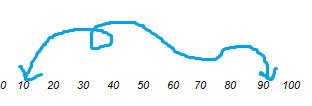Deciles > Interdecile Range
What is the Interdecile Range?
The interdecile range (IDR) is the distance between the 9th decile and the 1st decile (or the 10th and 90th percentiles). It is a measure of dispersion or spread; Cutting off the top and bottom 10% of scores eliminates the very high scores and very low scores, leaving you with a measure of where the bulk of scores are.

The IDR is similar to:
- The range , which measures from the smallest score to the largest score; It is wider than the IDR (by 10% in each direction).
- The interquartile range, which measures the middle 50% (trimming 25% off the top and bottom), compared to the middle 80% of the IDR (10% top and bottom trim).
The name “interdecile” comes from the fact that a decile is 10% of a set. When you find the interdecile range you’re basically cutting off the first and last deciles and then finding the range that’s left over.
How to Calculate the Interdecile Range
You have several options for calculating the IDR:
- If you already have a non-parametric seven number summary, you can use that to find the IDR. Just subtract the 10th percentile from the 90th.
- Use the PERCENTILE function in Excel (or OpenOffice, which is free) to find the 90th and 10th percentiles for your data. Then subtract the two.
- By hand: can be laborious, depending on the data, but you can find the steps to find percentiles here. Find the 90th and 10th percentiles, then subtract the two.
Relative Interdecile Range (RIDR)
The RIDR, described by Lutz et. al, is the 80% predictive interval divided by the by the median. As a formula, that’s:
Or, in deciles:
Values for the RIDR are relative to the median. For example:
- RIDR = 0.5: the difference between the 90th and 10th percentiles is 1/2 the median.
- RIDR = 1.0: the difference between the 90th and 10th percentiles is exactly the same as the median.
Let’s say you have a data set for the median price of homes. The median home price in your area is $150,000, with a range of $25,000 to $500,000. The 90th percentile is $450,000 and the 10th percentile is $50,000.
- IDR = $500,000 – $25,000 = $475,000. This tells you that the bulk of the house prices are contained within a spread of $475,000 (excluding the top and bottom deciles).
- RIDR = ($500,000 – $25,000)/ $150,000 = $475,000/$150,000 = 3.16. This tells you that the difference between the 90th percentile house price and 10th percentile house price is 3.16 times the median value.
References:
Lutz, W., W. C. Sandserson, and S. Scherbov. (2004). “The End of World Population Growth.” In The End of World Population Growth in the 21st Century, 17–83, edited by W.Lutz, W. C.Sandserson, and S.Scherbov. London: Earthscan. Retrieved 1/12/2017 from here.